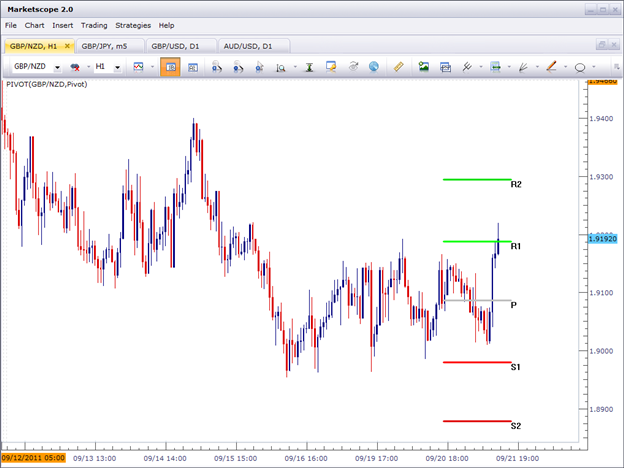Pivot Points
Support and Resistance is one of the more pertinent areas of technical analysis that can offer traders a bevy of potential options. For example, traders can use support and resistance levels for risk management, or the placement of stops. Traders can also use these levels in an effort to catch large, market-moving changes in price; often called a ‘breakout,’ as price breaks support and/or resistance in the quest of making new highs or lows.
There are numerous mannerisms of identifying support and resistance levels. Many traders will choose to gleam these levels directly on the chart. But charts weren’t always available for traders to assimilate these prices so alternative mechanisms were developed. Before computers became commonplace amongst floor traders, a more simplistic method of identifying potential support and resistance levels was needed.
This is where Pivot Points come into play. Pivots come in many different types of and variations. The most common form of Pivots, the mechanism created and passed on by generations of traders on the floor of the World’s largest exchanges is known as the ‘Floor-Trader Pivot.’ This can also be called ‘Classical Pivots.’
The name ‘Floor-Trader Pivot,’ came from the fact that Pivot points can be calculated quickly, on the fly using price data from the previous day as an input. Although time-frames of less than a day can be used, Pivots are commonly plotted on the Daily Chart; using price data from the previous day’s trading activity.

Chart created by James Stanley
Notice that the Pivot (signified with ‘P’ above) shows the Pivot value, with the Support and Resistance levels automatically plotted.
The calculation for Classic Pivots begins with the calculation of the ‘mid-line,’ or the Pivot itself. This is an ‘average,’ price using the previous day’s high, low, and close. The trader can add these 3 levels together, and divide by 3 to find the ‘Pivot,’ for the current day.
Pivot = (Previous day’s High + Previous day’s Low + Previous day’s Close)/3
This Pivot isn’t generally looked as Support or Resistance, but rather a mid-point with which the various support and resistance levels can be calculated. Now that we have the Pivot calculated, we can move on to calculate some Support and Resistance Levels. Pivots will generally provide at least 2 levels of Support and Resistance (these levels are commonly referred to as R1 and R2, or S1 and S2).
To calculate the first level of resistance, or R1, the trader can take the Pivot value we calculated previously, multiply by 2 and subtract the Low from yesterday to arrive at a price value.
R1 = (Today’s Pivot Value X 2) – Low from Yesterday
After the trader has calculated the first level of resistance, they can then move on to the first level of support, or S1. S1 is calculated in a very similar manner as R1. We can simply multiply the Pivot value from today times 2, and subtract
yesterday’s high to calculate the value for S1.
S1 = (Today’s Pivot Value X 2) – High from Yesterday
As you can see from the previous calculations, our pivot values will be greatly dependant on the price action that had taken place in the previous day. Oftentimes, traders will need an additional level of support and resistance if price action is particularly volatile. This is where the second level of support and resistance can come into play. Traders will often-times take pivots a step further by defining the S2 and R2 values.
The second level of Resistance is going to be at a higher price than R1, and can be calculated by adding the difference between R1 and S1, and adding to the Pivot value we had calculated previously.
R2 = Pivot from today + (R1 – S1)
The calculation of S2, once again, is similar to the calculation of R2. We simply want to subtract that difference between R1 and S1 from our Pivot value.
S2 = Pivot from today – (R1 – S1)
Now that levels are calculated and applied, traders can look to employ these areas of support and/or resistance with the strategies and market approach that they are trading.